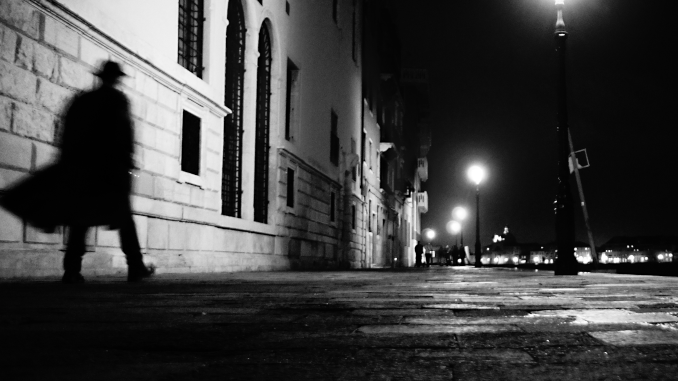
Today we’re serving up “Night and the City,” made in 1950, starring Richard Widmark (Harry Fabian), Gene Tierney (Mary Bristol), Googie Withers (Helen Nosseross), Herbert Lom (Kristo), Francis L. Sullivan (Philip Nosseross), Stanislaus Zbyszko (Gregorius), Hugh Marlowe (Adam Dunn), and Mike Mazurki (the Strangler). Directed by Jules Dassin, cinematography by Max Greene, screenplay by Jo Eisinger; based on the novel of the same name by Gerald Kersh.
“Night and the City” is a noir film of the criminal/gangster type, so the characters are, pretty much to a person, wholly unlikeable. In this story, nearly everyone screws over everyone else. You know that saying, “honor among thieves”? Yeah, there’s none to be found here.
It opens with Harry being chased through the night-time streets of London. Once he reaches his girlfriend Mary’s place, he tries to filch money from her purse without her knowing. And when she catches him at it, he lies, telling her he was looking for a cigarette. How does she know it’s a lie? There’s a container of cigarettes sitting right next to her purse.
Harry’s an operator, alright, but not a smooth one. Or, at least, not nearly as smooth or as clever as he believes himself to be.
At one point, Harry suffers a rare bout of self-pity, where he admits, “All my life, I’ve been running — from welfare officers, thugs, my father.” But Harry’s problem isn’t that he’s a victim of his past, because he also runs headlong toward every scheme that pops into his head to make it big, and Harry’s never off when it comes to working any and every angle to create yet another scam. (Adam describes Harry as being “an artist without an art” and warns Mary it’s a dangerous situation. Of course, she ignores the wisdom of his words.) Apparently, Harry’s “imagination” is one of the qualities Mary most admires about him, in fact, even though she complains that it’s these grand plans which are what’s keeping them apart. Harry’s hustles are hairbrained and doomed to failure, so, he ends up having to run away from the outcome (if the film’s opening is any indication, he has to literally run away from the consequences of these ill-conceived plots).
You can get a full synopsis of the story here.
You can watch Eddie Muller’s Noir Alley intro and outro, at these links, in case you missed watching the movie on TCM.
In good noir gangster story fashion, everyone meets some kind of tragic fate in the end, even if it’s simply being the one left behind.
If you like bleak stories where everyone is a backstabbing creep who’d sell you out in a heartbeat, well, this is your kind of film. The cinematography and storytelling tick all the noir boxes, so it’s fair to call it an example of the height of the noir style of filmmaking. For me, though, the casting of Americans Widmark, Tierney, and Marlowe leaves the audience experiencing cognitive dissonance as to why they were dropped into this film set in London’s seedy side. For that, I give it 3.5 out of 5 unfiltered cigarette puffs.
Next week’s film is 1949’s “The Window,” about a little boy who witnesses a murder, but because of his reputation for crying wolf, no one believes him.
As always, this is an open thread, so feel free to talk about whatever you like in the comments below. Happy Easter and have a great rest of your weekend!
